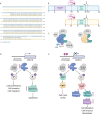CDK10 in Gastrointestinal Cancers: Dual Roles as a Tumor Suppressor and Oncogene
- PMID: 34277407
- PMCID: PMC8278820
- DOI: 10.3389/fonc.2021.655479
CDK10 in Gastrointestinal Cancers: Dual Roles as a Tumor Suppressor and Oncogene
Abstract
Cyclin-dependent kinase 10 (CDK10) is a CDC2-related serine/threonine kinase involved in cellular processes including cell proliferation, transcription regulation and cell cycle regulation. CDK10 has been identified as both a candidate tumor suppressor in hepatocellular carcinoma, biliary tract cancers and gastric cancer, and a candidate oncogene in colorectal cancer (CRC). CDK10 has been shown to be specifically involved in modulating cancer cell proliferation, motility and chemosensitivity. Specifically, in CRC, it may represent a viable biomarker and target for chemoresistance. The development of therapeutics targeting CDK10 has been hindered by lack a specific small molecule inhibitor for CDK10 kinase activity, due to a lack of a high throughput screening assay. Recently, a novel CDK10 kinase activity assay has been developed, which will aid in the development of small molecule inhibitors targeting CDK10 activity. Discovery of a small molecular inhibitor for CDK10 would facilitate further exploration of its biological functions and affirm its candidacy as a therapeutic target, specifically for CRC.
Keywords: CDK10; biliary tract cancer; colorectal cancer; cyclin-dependent kinases; gastric cancer; gastrointestinal cancers; hepatocellular carcinoma.
Copyright © 2021 Bazzi and Tai.
Conflict of interest statement
The authors declare that the research was conducted in the absence of any commercial or financial relationships that could be construed as a potential conflict of interest.
Figures

References
Publication types
LinkOut - more resources
Full Text Sources
Miscellaneous

